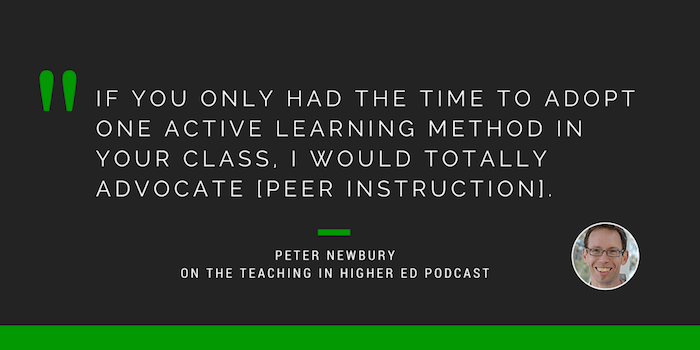Peter Newbury joins me to talk about peer instruction and using clickers in the higher ed classroom.
Early experiences with clickers
The Carl Wieman Science Education Initiative
Achieving the most effective, evidence-based science education
(effective science education, backed by evidence)The Carl Wieman Science Education Initiative (CWSEI) is a multi-year project at The University of British Columbia aimed at dramatically improving undergraduate science education.
The CWSEI helps departments take a four-step, scientific approach to teaching:
- Establish what students should learn
- Scientifically measure what students are actually learning
- Adapt instructional methods and curriculum and incorporate effective use of technology and pedagogical research to achieve desired learning outcomes
- Disseminate and adopt what works
Today's use of clickers and other audience response systems
- iClicker 2 radio clickers
- Colleagues use cards: A, B, C, D… Plickers…
- Bonni has a set of Turning Technologies RF clickers
Whether we are using physical devices, such as clickers, or we are using more of a bring your own device / smart phone /tablet option, it's really just a tool.
“I certainly don’t want to say that in order to use peer instruction, you have to have this piece of technology. It’s not about the clicker.” #peerinstruction
“Peer instruction is not a shiny thing that comes with clickers. Clickers are one tool you can use to facilitate peer learning.”
Peer Instruction foundations
How People Learn (free ebook) states that experts must:
- Have a deep foundation of factual knowledge
- Understand those facts and concepts in a conceptual framework
- Organize the knowledge in ways that facilitate retrieval and application
More on peer instruction basics:
- “If I’m not making your brains work, then I’m not teaching hard enough.”
- “We need to schedule time into the class where students can stop and think, and start to learn.”
- “Just stop talking for a while and let the students start to think.”
Effective Peer Instruction Questions
- Peter's post on what makes for good peer instruction questions? And what makes bad ones?
- “If I can just ask Siri the answer to the question, that’s [not a good one for peer instruction].”
- Removing barriers to learning, such as high stakes questions/exercises
- “…not about getting the right answer, but about practicing how to think.” Homework question will have the opportunity to assess for correctness.
Experts vs novices
“The expert has the same content as the novice, but it’s organized [and more easily retrieved]…”
Recommendations
Bonni recommends:
Peter recommends:
- Get yourself into a learning community. Get on Twitter.
- Bonni mentioned Peter's Twitter list of Teaching / Learning Centers








